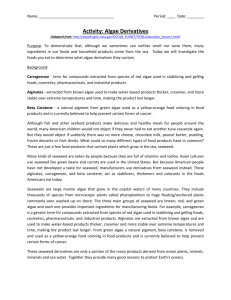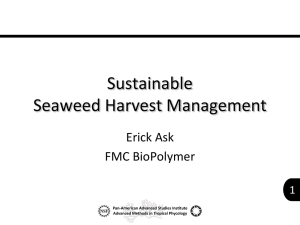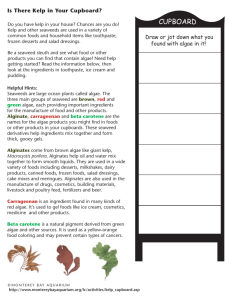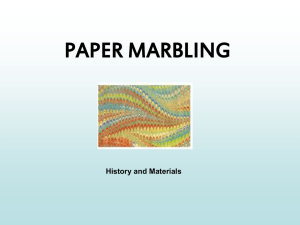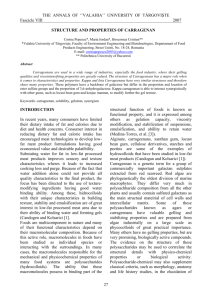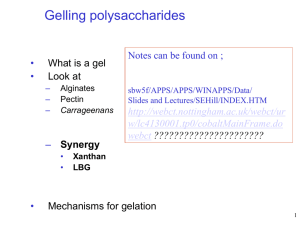refilda ok
advertisement
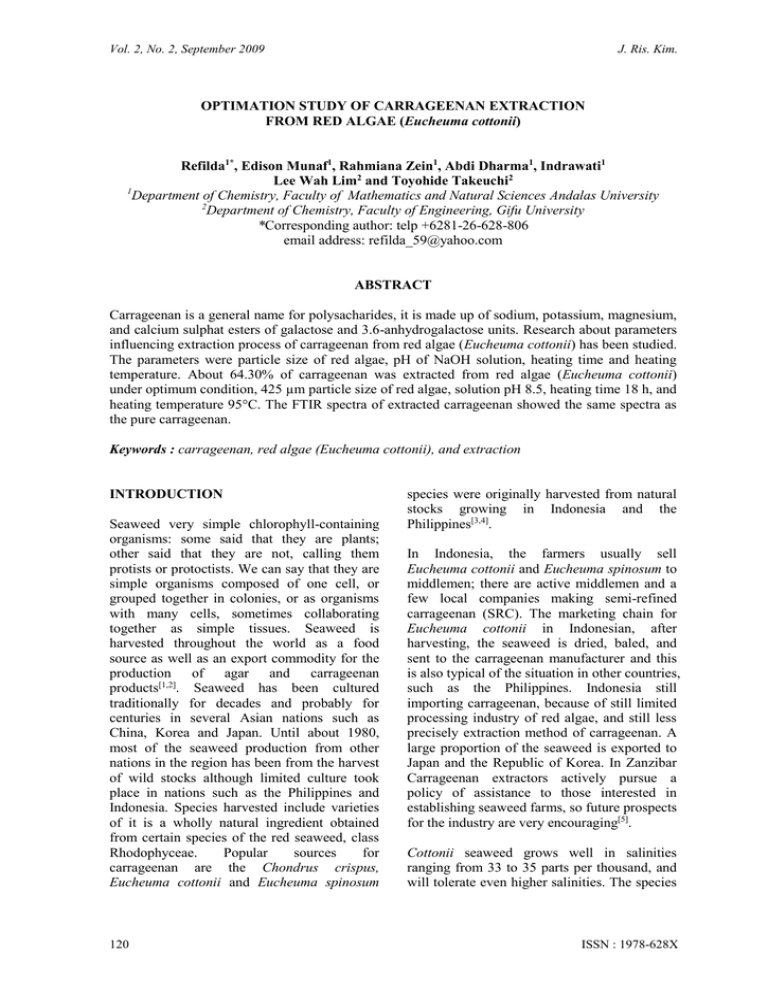
Vol. 2, No. 2, September 2009 J. Ris. Kim. OPTIMATION STUDY OF CARRAGEENAN EXTRACTION FROM RED ALGAE (Eucheuma cottonii) Refilda1*, Edison Munaf1, Rahmiana Zein1, Abdi Dharma1, Indrawati1 Lee Wah Lim2 and Toyohide Takeuchi2 1 Department of Chemistry, Faculty of Mathematics and Natural Sciences Andalas University 2 Department of Chemistry, Faculty of Engineering, Gifu University *Corresponding author: telp +6281-26-628-806 email address: refilda_59@yahoo.com ABSTRACT Carrageenan is a general name for polysacharides, it is made up of sodium, potassium, magnesium, and calcium sulphat esters of galactose and 3.6-anhydrogalactose units. Research about parameters influencing extraction process of carrageenan from red algae (Eucheuma cottonii) has been studied. The parameters were particle size of red algae, pH of NaOH solution, heating time and heating temperature. About 64.30% of carrageenan was extracted from red algae (Eucheuma cottonii) under optimum condition, 425 µm particle size of red algae, solution pH 8.5, heating time 18 h, and heating temperature 95°C. The FTIR spectra of extracted carrageenan showed the same spectra as the pure carrageenan. Keywords : carrageenan, red algae (Eucheuma cottonii), and extraction INTRODUCTION Seaweed very simple chlorophyll-containing organisms: some said that they are plants; other said that they are not, calling them protists or protoctists. We can say that they are simple organisms composed of one cell, or grouped together in colonies, or as organisms with many cells, sometimes collaborating together as simple tissues. Seaweed is harvested throughout the world as a food source as well as an export commodity for the production of agar and carrageenan products[1,2]. Seaweed has been cultured traditionally for decades and probably for centuries in several Asian nations such as China, Korea and Japan. Until about 1980, most of the seaweed production from other nations in the region has been from the harvest of wild stocks although limited culture took place in nations such as the Philippines and Indonesia. Species harvested include varieties of it is a wholly natural ingredient obtained from certain species of the red seaweed, class Rhodophyceae. Popular sources for carrageenan are the Chondrus crispus, Eucheuma cottonii and Eucheuma spinosum 120 species were originally harvested from natural stocks growing in Indonesia and the Philippines[3,4]. In Indonesia, the farmers usually sell Eucheuma cottonii and Eucheuma spinosum to middlemen; there are active middlemen and a few local companies making semi-refined carrageenan (SRC). The marketing chain for Eucheuma cottonii in Indonesian, after harvesting, the seaweed is dried, baled, and sent to the carrageenan manufacturer and this is also typical of the situation in other countries, such as the Philippines. Indonesia still importing carrageenan, because of still limited processing industry of red algae, and still less precisely extraction method of carrageenan. A large proportion of the seaweed is exported to Japan and the Republic of Korea. In Zanzibar Carrageenan extractors actively pursue a policy of assistance to those interested in establishing seaweed farms, so future prospects for the industry are very encouraging[5]. Cottonii seaweed grows well in salinities ranging from 33 to 35 parts per thousand, and will tolerate even higher salinities. The species ISSN : 1978-628X J. Ris. Kim. Vol. 2, No. 2, September 2009 is intolerant of lower than normal salinities, which are generally rare on outer-island coral reef flats, occurring only for short periods when heavy rain coincides with a period of low water movement. Lower than normal salinities are more common in lagoon environments, and cottonii survival will be dependent on the proximity to flushing with oceanic water, and the duration of low salinity periods. Commercial growth rates are achieved in shallow water temperatures ranging from 24°C to 30.5°C[6]. In Indonesia eucheuma farms were found in Sulawesi, Bali, Lombok, Sumbawa, Seribu Island, Ratu Harbour, Lampung, Aceh and West Sumatera[7]. Carrageenan is a substance with hydrocolloid properties owing to the presence of sodium, potassium, magnesium and calcium sulfate esters of galactose and 3, 6-anhydrogalactose units. Carrageenans are large, highly flexible molecules which curl forming helical structures. This gives them the ability to form a variety of different gels at room temperature. They are widely used in the food and other industries as thickening and stabilizing agents[8,9]. A particular advantage is that they are thixotropic—they thin under shear stress and recover their viscosity once the stress is removed. This means that they are easy to pump but stiffen again afterwards[10]. Most carrageenan was extracted from Kappaphycus alvarezii (Eucheuma cottonii) and Eucheuma spinosum into water or aqueous dilute alkali and may be recovered by alcohol precipitation[11,12]. The original source of carrageenan was Chondrus crispus, and this is still used to a limited extent. Betaphycus gelatinum is used for a particular type of Kappa Carrageenan carrageenan. Some South American species that have previously been used to a limited extent are now gaining favour with carrageenan producers as they look for more diversification in the species available to them and the types of carrageenan that can be extracted. Gigartina skottsbergii, Sarcothalia crispata and Mazzaella laminaroides are currently the most valuable species, all collected from natural resources in Chile. Small quantities of Gigartina canaliculata are harvested in Mexico. Hypnea musciformis has been used in Brazil[13]. Carrageenan is used in processed foods for stabilization, thickening, and gelation. It has been successfully used by the food industry in the US since the 1950s, and with increasing demand driven by the consumers need for convenience, appealing food textures, advances in food processing, and new food products. It is used worldwide to enhance ice creams, chocolate milk, custards, cheeses, jellies, confections, meats, and protein drinks. Carrageenan is an approved food additive. Carrageenan from red algae is benefit to health, food industry, beverage, cosmetic, pharmacy, paint, textile and others. Indonesia still importing carrageenan, because of still limited processing industry of red algae, and still less precisely extraction method of carrageenan[14]. In order to increase production of carrageenan, research about some parameters that influencing extraction process of carrageenan from red algae (Eucheuma cottonii) by alkaline solution were studied. The parameters were particle size of red algae, pH of NaOH solution, heating time and heating temperature. Iota Carrageenan Lambda Carrageenan Fig. 1 Three types of carrageenan[10] ISSN : 1978-628X 121 Vol. 2, No. 2, September 2009 J. Ris. Kim. MATERIAL AND METHODS RESULT AND DISCUSSIONS Treatment of Red algae (Eucheuma cottonii) Effect of Particle Size on Extraction Yield Carrageenan Eucheuma cottonii, 40 days age, was harvested from Seurapong village of Pulau Aceh district at Aceh Besar sub-province of NAD. Eucheuma cottonii was extensively washed with distilled water to remove particulate material from their surface and dried under sunlight. Dried biomass was cut, ground in a grinder and then was screened to particle size of 150-425 μm. Chemicals and Apparatus All reagents in this research were pure. The reagents were NaOH, isopropyl alcohol, KCl, Standard Buffer Solution pH 4.0 and 7.0, filter paper (Merck pro analysis) and distilled water. The apparatus were used in this study were grinder, octagon 200, Endcots, London, Inggeris screener, analytical balance (AA-200, Denver Instrument Company), pHmeter (Denver Instrument Company), FTIR (Bio-Rad FTS 60), water bath, vacuum pump, oven, desiccators, and glasses that usually used in laboratory. Procedure Carrageenan is obtained by extraction of 10 g dried Eucheuma cottonii at various particle size into 500 mL of alkaline solution (pH 8) with steam boiling to maintain temperature about 90°C and continues stirring for about 3 hours. Filtered and precipitated in isopropyl alcohol 1:3, than dried in oven at 60°C, weighted and milled to find powder. The same procedures were done for various pH of solutions, heating time and heating temperature. FTIR Spectroscopy Analysis was done to see functional groups of carrageenan. For the IR studies, 5% (wt/wt) of ground, dried extracted carrageenan and pure carrageenan were pressed in KBr discs. The FTIR spectra were recorded in the 1500500 cm-1 spectral range using a Bio-Rad FTS 60 instrument. A total of 128 scans were averaged for each sample with a resolution of 2 cm-1. 122 The carrageenan extraction of the red algae with alkaline solution was studied. Percentation of carrageenan was influenced by particle size of read algae and carrageenan, as shown in Figure 1. Figure 1 shows that percentage of carrageenan increases with increasing particle size of Eucheuma cottonii from 150 μm to 425 μm. At particle size higher than 425 μm, the percentage of carrageenan remind constant, and particle size lower than 425 μm gave lower percentage of carrageenan because it was difficult to separated filtrate and residu by filtering and gave much waste. Although percentage of carrageenan exracted from Eucheuma cottonii was optimum at particle size 425 μm, the result indicated that for other size still satisfactory. For the further experiment particle size 425 μm was selected. Effect of Heating Time on Extraction Yield of Carrageenan The effect of heat treatment on the yield of carrageenan extracted from Eucheuma cottonii was examined. The result is shown in Figure 2. It indicated that the highest percentage of carrageenan was produced after heating 18 h at 90°C. Heating time lower than 18 h gave lower percentage of carrageenan because not all carrageenan was extracted into alkaline solution yet and heating time higher than 18 h gave high solution concentration and it was difficult to separated between filtrate and residue. Effect of pH on Yield of Extracted Carrageenan In Figure 3 the extraction yield of carrageenan from Eucheuma cottonii depends on pH, the percentage of carrageenan increased with the increasing pH from 8.0 to 8.5 and then decreased in the range 8.5-10. As the pH increased, the negative charge density on the solution will increase and increasing the attraction of metallic ions with positive charge ISSN : 1978-628X J. Ris. Kim. Vol. 2, No. 2, September 2009 on the Eucheuma carrageenan[15,16]. cottonii and formed Effect of Heating Temperature Extraction Yield of Carrageenan on Caragenan Result (%) The extraction yield of of carrageenan was affected by heating temperature of Eucheuma cottonii. The carrageenan diluted in hot alkaline solution from 70-100C. In this investigation heating temperature 95C gave the higher percentage of carrageenan result. At heating temperature lower than 95C not all carrageenan was produced and heating temperature higher than 95 C the concentrated solution was produced and it was difficult to separate filtrate and residue. Extracted carrageenan from red algae (Eucheuma cottonii) by alkaline solution in optimal condition is 64.31%. It is higher than the result was found by Syamsuar [4] 52 50 48 100 200 300 400 500 Particle Size (um) Figure 1. Extraction yield of carrageenan from various particle size of Eucheuma cottonii treated with NaOH solution at pH 8.5 Conditions: weight of material =10 g, heating time =12 h and heating temperature = 90 oC Carrageenan result (%) Carrageenan result (%) 60 55 50 45 40 35 30 70 65 60 55 50 45 40 35 30 25 20 0 5 10 15 20 25 30 Heating time (h) Figure. 2. Extraction yield of carrageenan from various heating time of Euchemia cottonii Conditions: weight of material = 10 g, particle size = 425 µm, solution of pH = 8.5 and heating temperature = 90C ISSN : 1978-628X 7.5 8 8.5 9 9.5 10 10.5 pH Figure. 3. Extraction yield of carrageenan from several solutions of pH of Eucheuma cottonni Conditions: weight of material 10 g, particle size = 425 µm, heating time = 18 h, heating temperature = 90C. 123 J. Ris. Kim. Vol. 2, No. 2, September 2009 FTIR Analysis The functional groups of carrageenan that produced by alkaline solution extraction and pure carrageenan ware determined by FTIR[17]. The spectra are shown in Figure 5. The functional group of both carrageenan almost the same. The spectra could explained that the extracted carrageenan from Eucheuma cottonii was almost pure. The study of carrageenans by FTIR spectroscopy shows the presence of very strong absorption bands in the 1266 cm-1 region (due to the S=O of sulfate esters) and 1068 cm-1 region (described to the glycosidic linkage) in all carrageenan types. The other chemical groups are characteristics of a given carrageenan type, namely 3,6-anhydro-Dgalactose at 929 cm-1, D-galactose-4-sulfate at 846 cm-1. D-galactose-2-sulfate at 820 – 830 cm-1 and 3,6-anhydro-D-galactose-2-sulfate at 800-805 cm-1. The spectra could explain that the extracted carrageenan from Eucheuma cottonii almost pure. Mainly carrageenans of the k-type has strong band at approximately (bands at 933 and 847 cm-1) and i-type (bands at 933, 847 and 805 cm-1)[18]. The FTIR spectrumof alkali-modified polysaccharide resembled k-carrageenan from red alga Phacelocarpus peperocarpos with absorption at 930 cm-1 (indicative of AnGal) and 850 cm-1 (Gal 4-sulfate) and at 820 cm-1 indicating the presence of equatorial sulfate ester substitution at O-6 of gal residues[19]. Carrageenan result (%) 80 70 60 50 40 30 20 80 85 90 95 100 105 110 Heating temperature (oC) Figure. 4. Extraction yield of carrageenan from various heating temperature of Eucheuma cottonii. Conditions: weight of material 10 g, particle size = 425 µm, heating time = 18 h %T A B 4000 450 Cm-1 Figure 5. FT-IR spectra of pure carrageenan (A) and extracted carrageenan from Red algae (Eucheuma cottonii) ISSN : 1978-628X 125 J. Ris. Kim. Vol. 2, No. 2, September 2009 a b c Fig. 6. SEM image of a. red algae (Eucheuma cottonii), b. extracted carrageenan and c. pure carrageenan Figure 6 shown that surface of extracted carragenan from red algae is identical with pure carageenan. Carrageenan has much pore and big hole compared with red algae. CONCLUSION In conclusion, carrageenan could be extracted from Eucheuma cottonii by alkaline solution and precipitate by isopropyl Alcohol ander optimal condition, particle size 425 µm alkaline solution pH 8.5, heating time 18 h and heating temperature 95C. Based on FTIR spectra and SEM image the extracted carrageenan shown the same functional groups and particle pore as the pure carrageenan. REFERENCES 1. R. B. William, Post Harvest treatment and Quality Control of Eucheuma Seaweeds, Proceedings of the regional workshop on seaweed culture, 2/18/2007, (2007) 2. FAO, Training Manual on Gracilaria Culture and Seaweed Processing in China, 2/6/2007 3. C. Brian, Seaweed`Farming: An Alternative Livehood for Small-scale Fishers, Coastal Resources Center, University of Rhode Island, 2002. 4. Syamsuar, Karakteristik Karaginan Rumput Laut (Eucheuma cottonii) pada Berbagai Umur Panen, Konsentrasi,KOH dan Lama Ekstraksi, thesis, Sekolah Pasca Sarjana IPB, 2006. 5. E. W. Julian, N. W. Hira, The Growth of seaweed Commudity in Indonesia, 2006. ISSN : 1978-628X 6. L. David, Potencial for Eucheuma cottonii Seaweed Farming in Semoa, Food and Agriculture organization of The United Nations, 1999. 7. J. M. Dennis, Prospect for Eucheuma Marketing in The World and The Future of Seaweed Farming in Pacific, dept of chemistry, University of New South Wales, Campbell, Australia, 2007 . 8. Benford, Safety evaluation of Certain Food Additives and Contaminants. Carrageenan and Processed Eucheuma Seaweed (addendum), 2007. 9. A. Kelco, Carrageenan. Denmark. http://www.cPKelco.com. 2004 (16-092006) 10. J. Minghou, Processing and Extraction of Phycocoloids, FAO, Corporate Document Repository, 2007. 11. S. Otles, Methods of Analysis of Food Components and Additives, Taylor &Francis Group, LLC, 2005. 12. FAO, Seaweeds Used as A Source of carrageenan, Fisheries department, 4/20/2007. 13. MS. Doty, The Production and Use of Eucheuma, Department of Botany, University of Hawaii 2/18/2007. 14. MS. Doty , Eucheuma alvarezii sp.nov (Gigartinales, Rhodophyta) from Malaysia in Abbot IA, Norris JN (editors). Taxonomy of Economic Seaweeds California Sea Grant College Program. 1985, 37 – 45. 15. F. U. Sandra, J. E. Allan, M. F. Mohammed, B. K. Richard and T. C. Gregory, Carbohydrate Research, 340: 1357–1364, (2005). 125 Vol. 2, No. 2, September 2009 16. J. M. Estevez, M Ciancia and AS Cerezo, Carbohydrate Research, 339: 2575.– 2592, (2004). 17. M. L. Liao, A. Chiovvitti, S. L. A. Munro, D. J. Craik, G. T. Kraft, A. Bacic, Carbohydrate Research, 296: 237-247, (1996). 126 J. Ris. Kim. 18. T. A. Davis, B. Volesky, A. Mucci, Water Res., 37: 4311-4330, (2003). 19. C. Marcela, A. S. Barros, A. Nunes, S. M Rocha, I. Delgadillo, C. Jana, Manuel, Use of FT-IR spectroscopy as a tool for the analysis of polysaccharide Food additives, Carbohydrate Polymers, 51: 383–389, (2003). ISSN : 1978-628X
